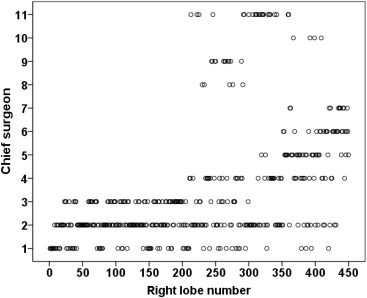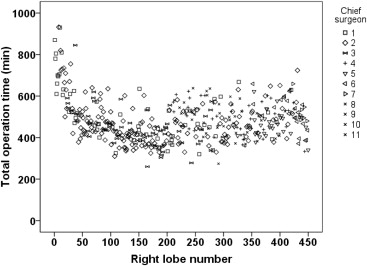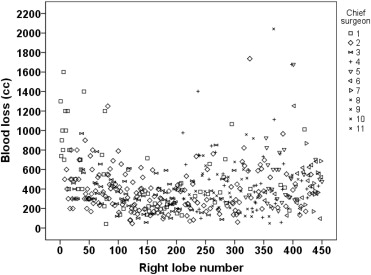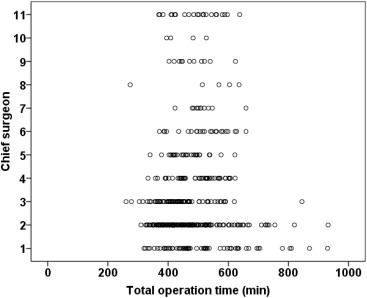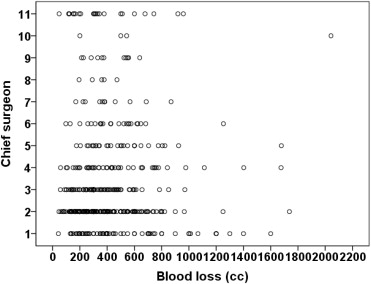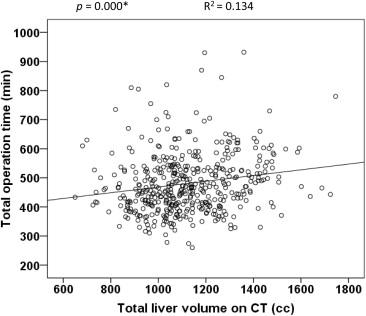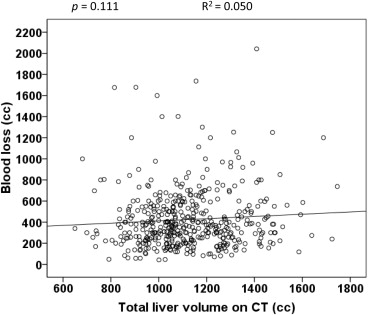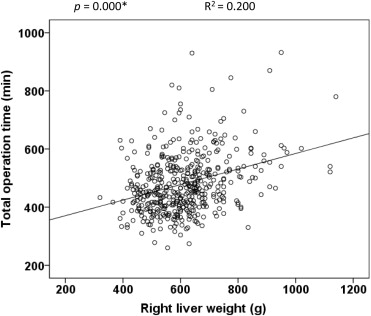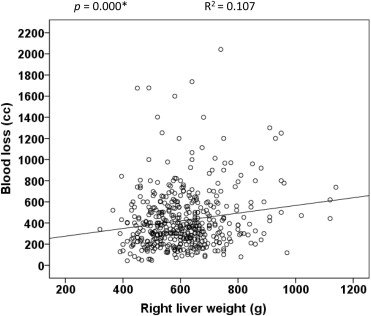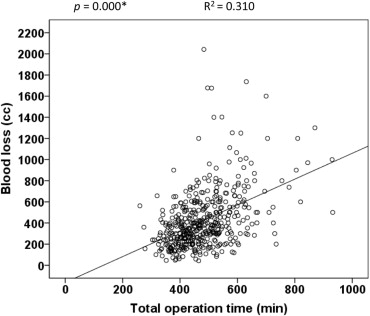Summary
Background/Objective
Donor right hepatectomy (DRH) was developed by master liver surgeons and has been applied in many liver transplant centers as the mainstay for adult living donor liver transplantation. It is a major and complex surgical operation performed on living liver donors for the benefit of liver recipients. The donors deserve the lowest though inevitable morbidity and mortality. In this study, the surgical outcomes of DRH performed by newer surgeons at an established center were studied to assess the transferability of the techniques of this standardized procedure.
Methods
We studied 450 consecutive DRHs performed by 11 surgeons. Three surgeons initiated and developed the transplant program and performed the first 200 DRHs (Era I). The role of chief surgeon in the following 250 DRHs (Era II) was gradually taken up by four newer surgeons with close guidance initially.
Results
Blood loss and operation time at the end of Era I versus the beginning of Era II were 251 vs. 341 mL and 391 vs. 497 minutes. The learning curve effect in Era I did not occur in Era II. The complication rates of the last 50 cases in Era I and Era II were 16% and 24%, respectively. Era I had one donor death whereas Era II had no donor death.
Conclusion
At an established center, DRH can be carried out safely by newer surgeons with good outcomes.
Keywords
donor hepatectomy;liver transplantation;living
1. Introduction
Living donor liver transplantation (LDLT), when applied to adult recipients, often requires the right liver in order to provide a graft of adequate size. Donor hepatectomy is a very major surgical operation and is performed on healthy volunteers only. Donor left hepatectomy, which can provide a liver graft adequate for a recipient of small body size, carries an estimated mortality rate of 0.1%, whereas donor right hepatectomy (DRH) has an estimated mortality rate of 0.5%.1 Although donor death has occurred in almost every continent, the contemporary standard of donor hepatectomy globally has yet to be determined and ought to be updated. How reporting of morbidities and mortalities improves the safety of donor hepatectomy has not been examined or proven. Whether accumulation of knowledge of these donor procedures affects the practice of surgery is also unknown. In 2009, encouraging research by the Japanese Liver Transplantation Society reported a donor morbidity of less than 10% and mortality of 0.03%.2 However, in 2010, two living liver donors died from the operation in the United States. A total of four living liver donor deaths have occurred in the United States.
In one of our previously published studies, the outcomes in the consecutive first 200 living right liver donors were analyzed and discussed. There was an obvious improvement of donor outcomes with time. A learning curve phenomenon was demonstrable. The operation time and blood loss decreased with time, and the curve was steepest for the first 50 cases. The complication rate also dropped from 34% in the first 50 donors to 16% in the remaining three subgroups, each with 50 donors. Unfortunately, in the fourth subgroup of 50 donors, one donor died 10 weeks after surgery from a duodenal ulcer that had perforated into the inferior vena cava.3 With the wider applicability of right-liver LDLT, there are more DRHs and hence more surgeons are required. This study evaluates the feasibility of this operation being continued by a newer group of surgeons at our center and analyzed the surgical outcomes. To be qualified to be a trainee in LDLT at our center, one must be a qualified specialist surgeon in general surgery, that is, having undertaken a 6-year training in general surgery and passed the required examinations, and must have at least 1-year experience in hepatobiliary and pancreatic surgery.
2. Methods
Four hundred and fifty consecutive living liver donors (case numbers 1–450) who underwent DRH at our hospital were included in the study. DRH has been described previously.4 In brief, it is performed via a right subcostal incision with an upper midline extension. Intraoperative cholangiography under fluoroscopy is employed to plan the line of division of the right hepatic duct(s) prior to liver transection. Temporary right liver inflow control reveals the Cantlie line, which is marked by cautery to guide liver transection using Cavitron Ultrasonic Surgical Aspirator (CUSA; Valleylab, Boulder, CO, USA). The right hepatic ductal stump is closed with 6/0 polydioxanone monofilament suture (Ehticon, Edinburgh, UK). Operative cholangiography is performed to confirm the integrity and patency of the main and left ductal systems. The right hepatic artery and portal vein are divided after the application of vascular clamps. The delivery of the right liver graft is preceded by the application of an endovascular stapler (TA30, Tyco; Healthcare, Norwalk, CT, USA) to the site of the right and middle hepatic veins. These veins are cut flush with the staples. A bile leakage test is performed by instillation of dilute methylene blue into the main and left biliary system. All except three of the 450 cases had the middle hepatic vein included in the graft.5 From July 2000, an abdominal drain was not deployed in the donor on completion of DRH.6
Prospectively collected data included donor characteristics and peri/postoperative outcomes. Complications were recorded and graded according to the Clavien-Dindo classification.7 Data analysis was done with the nonparametric test using the PAW program. The 450 cases were divided into nine groups, each with 50 cases. The first 200 cases were classified as Era I, and the remaining 250 cases were classified as Era II. Such classification was based on the fact that after the first 200 cases, newer surgeons were included as operators in the DRHs. Groups 1–4 belonged to Era I, and Groups 5–9 belonged to Era II. Operative outcomes were compared between the eras as well as the groups. A p value less than 0.05 was considered statistically significant.
3. Results
A total of 450 DRHs were included. In Fig. 1, the case numbers are plotted against the 11 surgeons who were the chief operators of the DRHs. Surgeons 1, 2, and 3 initiated and developed the LDLT program. Surgeons 4, 5, 6, and 7 in chronological order joined the service. Surgeons 8, 9, 10, and 11 were liver transplant fellows who underwent training in the service.
|
|
|
Figure 1. Cases performed by 11 surgeons as chief operators. |
Most of the donors were Chinese (97% in Era I, 94% in Era II). As shown in Table 1, there are no statistically significant differences in donor characteristics between Era I and Era II. Donor surgical outcomes are listed in Table 2. The operation time was shortened to 391 minutes by the end of Era I but returned to 497 minutes in the beginning of Era II, and there was no apparent reduction in operation time thereafter. Similarly, blood loss was reduced to 251 mL by the end of Era I but rebounded to 341 mL in the beginning of Era II and remained at this level by the end of Era II. Blood transfusion was given to two donors, one in the first 50 cases in Era I (Group 1) and the other in the last 50 cases of Era II (Group 9). Intensive care unit stay and general ward stay did not vary much between eras.
| Era I (Cases 1 to 200) | Era II (Cases 201 to 450) | p | |
|---|---|---|---|
| Age (y) | 35 (18-57) | 33 (18-59) | 0.26 |
| Male:female | 74:126 | 98:125 | 0.63 |
| Body weight (kg) | 56.1 (37–108.5) | 56.7 (37.6–95) | 0.48 |
| Body height (cm) | 161.7 (144.5–188) | 163 (140.5–183) | 0.12 |
| Body mass index | 21.3 (15.6–35.6) | 21.1 (16–30) | 0.48 |
| Remnant left liver/total liver volume | 0.35 (0.24–0.50) | 0.35 (0.27–0.51) | 0.06 |
| Ethnicity | |||
| Chinese | 194 (97%) | 235 (94%) | |
| Filipino | 1 | 2 | |
| White | 2 | 1 | |
| Indian | 1 | 1 | |
| Burmese | 1 | 0 | |
| Japanese | 1 | 1 | |
| Vietnamese | 0 | 1 | |
| Indonesian | 0 | 2 | |
| Bangladeshi | 0 | 1 | |
| Pakistani | 0 | 3 | |
| Malaysian | 0 | 1 | |
| Mongolian | 0 | 2 | |
| Era I | Era II | ||||||||
|---|---|---|---|---|---|---|---|---|---|
| Group 1 | Group 2 | Group 3 | Group 4 | Group 5 | Group 6 | Group 7 | Group 8 | Group 9 | |
| Operation time (min) | 598 (378–932) | 469 (388–640) | 414 (310–602) | 391 (304–635) | 497 (278–638) | 457 (274–636) | 451 (358–668) | 484 (378–659) | 507 (33–724) |
| Blood loss (mL) | 500 (200–1600) | 410 (42–1250) | 286 (46–716) | 251 (95–595) | 341.5 (71–1402) | 339.5 (88–1066) | 371 (61–1737) | 393 (48–2042) | 442 (97–1678) |
| Blood transfusion | 1 (2%) | (0%) | (0%) | (0%) | (0%) | (0%) | (0%) | (0%) | 1 (2%) |
| Intensive care unit stay (d) | 2 (1–8) | 1 (1–5) | 1 (0–4) | 1 (1–3) | 1 (1–3) | 1 (0.5–4) | 1 (1–11) | 1 (1–9) | 1 (1–6) |
| General ward stay (d) | 8 (3–35) | 8 (3–20) | 6 (2–18) | 5 (2–14) | 6 (3–14) | 5 (2–10) | 6 (4–26) | 8 (3–24) | 6 (2–18) |
| Total hospital stay (d) | 10 (5–38) | 9 (6–22) | 7.5 (5–19) | 6.5 (4–16) | 7 (5–15) | 7 (5–12) | 7 (5–28) | 9 (5–25) | 7 (5–20) |
Operation time and blood loss with respect to the case numbers are shown in Figs. 2 and 3, respectively. Individual surgeons are labeled with different signs in the graphs. The operation time (Fig. 4) and blood loss (Fig. 5) of each case are also plotted against the chief surgeon of the case.
|
|
|
Figure 2. Operation time plotted against case numbers. |
|
|
|
Figure 3. Blood loss plotted against case numbers. |
|
|
|
Figure 4. The operation time of cases performed by each surgeon as chief operator. |
|
|
|
Figure 5. Blood loss in the cases performed by each surgeon as chief operator. |
Total liver volume on computed tomography had a positive correlation with operation time (R2 = 0.134, p < 0.001) ( Fig. 6) but not with blood loss (R2 = 0.050, p = 0.11) ( Fig. 7). However, a positive correlation could be found between graft weight as measured on the back table and operation time (R2 = 0.200, p < 0.001) ( Fig. 8) as well as blood loss (R2 = 0.107, p < 0.001) ( Fig. 9). A positive correlation was also found between blood loss and operation time (R2 = 0.310, p < 0.001) ( Fig. 10).
|
|
|
Figure 6. Operation time plotted against total liver volume as measured on computed tomography. |
|
|
|
Figure 7. Blood loss plotted against total liver volume as measured on computed tomography. |
|
|
|
Figure 8. Operation time plotted against right liver weight as measured on the back table. |
|
|
|
Figure 9. Blood loss plotted against right liver weight as measured on the back table. |
|
|
|
Figure 10. Blood loss plotted against operation time. |
Complications are listed in Table 3. The complication rate in Era I dropped to 16% after the first 50 cases, but the rate was 24% by the end of Era II. One donor in Era I died 10 weeks after the operation, whereas there was no donor death in Era II. One case of Clavien-Vb complication (severe systemic inflammatory response syndrome) and one case of Clavien-Va complication (slippage of vascular clamp on the right hepatic vein during graft delivery) occurred in Groups 7 and 9, respectively.
| Era I | Era II | ||||||||
|---|---|---|---|---|---|---|---|---|---|
| Grade | Group 1 | Group 2 | Group 3 | Group 4 | Group 5 | Group 6 | Group 7 | Group 8 | Group 9 |
| I | 8 4 wound infections 1 intraoperative pneumothorax 1 cholestasis 1 peroneal nerve palsy 1 occipital pressure sore | 5 2 wound infections 2 cholestasis 1 lung collapse | 8 6 wound infections 1 occipital sore 1 pleural effusion | 3 3 wound infections | 5 2 wound infections 1 DVT 2 occipital pressure sore | 6 1 wound infection 2 pleural effusion 1 atelectasis 1 occipital pressure sore 1 right diaphragmatic hernia | 11 1 wound infection 1 ileus 1 ascites 2 occipital pressure sore 2 atelectasis 4 pleural effusion | 5 1 pleural effusion 1 atelectasis 1 brachial plexis palsy 1 ileus 1 peroneal nerve palsy | 6 1 occipital pressure sore 1 brachial nerve injury 1 anxiety attack 2 ileus 1 ascites |
| II | 4 2 wound infection 2 urinary tract infection | 2 1 wound infection 1 requiring parenteral nutrition | 0 | 2 1 urinary tract infection 1 pleural effusion | 1 Urinary tract infection | 4 1 urinary tract infection 1 atelectasis 1 infected ascites 1 psychosis | 8 2 chest infections 2 urinary tract infections 1 subphrenic collection 1 fast atrial fibrillation 1 wound infection 1 sacral pressure sore | 4 1 atelectasis 1 drip site cellulitis 1 pulmonary embolism 1 portal vein partial thrombosis | 8 1 delirium 2 drip site thrombophlebitis 1 forearm hematoma 1 myocardial infarction 1 depression 1 pulmonary embolism 1 skin (shin) infection |
| IIIa | 1 Bleeding duodenal ulcer | 1 Bile duct stricture | 0 | 1 Dog-ear appearance of wound | 1 Ascites | 2 1 biliary stricture 1 subphrenic collection | 2 1 bile leakage 1 subphrenic abscess | 4 1 biliary stricture 1 biliary sludge 1 left duct injury 1 intra-abdominal collection | 0 |
| IIIb | 4 1 bile duct stricture 1 intestinal obstruction 1 incision hernia 1 intraoperative portal vein thrombosis | 0 | 0 | 1 Hemoperitoneum | 0 | 1 Hemoperitoneum | 2 1 intraoperative right hepatic artery injury 1 infective peritonitis | 0 | 0 |
| IVa | 0 | 0 | 0 | 0 | 0 | 0 | 0 | 0 | 1 Torrential bleeding and cardiac arrest from right hepatic vein (slippage of vascular clamp) |
| IVb | 0 | 0 | 0 | 0 | 0 | 0 | 1 Severe systemic inflammatory response syndrome | 0 | 0 |
| V | 0 | 0 | 0 | 1 Duodenocaval fistula | 0 | 0 | 0 | 0 | 0 |
| Rate | 34% (34%) | 16% (16%) | 16% (16%) | 16% (16%) | 14% (8%) | 26% (22%) | 48% (28%) | 26% (22%) | 30% (24%) |
DVT = deep vein thrombosis.
4. Discussion
Proficiency in DRH has been acquired by the newer surgeons, testifying to the transferability of such expertise at a well-developed liver transplant center. This is attributable to a number of factors. In the process, guidance is provided by more experienced surgeons and surgical outcomes are continuously monitored. Furthermore, the DRH performed at our center is a much standardized procedure.8
The learning curve effect of the first 50 cases in Era I did not appear when newer surgeons took over in Era II. The learning curve can most conveniently be represented by the time or the number of cases an average surgeon or center needs for a procedure to be performed with reasonably favorable outcomes. Operation time, blood loss, and complication rate are often the parameters of reference. DRH for adult LDLT was originated by this center and was based on the extensive local experience of major hepatectomy for hepatocellular carcinoma.9 Since it was an original surgical operation, a learning curve of 50 cases is understandable. When other centers acquire the technique, their learning period can be shortened. In donor operations, the consistent reduction of the operation time and blood loss with time has been well demonstrated.10 The same experience was also reported by centers in Germany,11 Korea,12 and Japan.13 It is a policy that in preparation for the surgical responsibility as chief surgeon, experience is gained by assisting in DRHs as well as hepatectomies for tumors. Furthermore, initially, the operation is supervised and guided by an experienced surgeon. As a whole, the operation time (Fig. 2) and blood loss (Fig. 3) in Era II were comparable with those in Era I, and were acceptable.
Liver transection time correlates with transection surface area.14 ; 15 There was a positive correlation of operation time with the volume of the whole liver (Fig. 6) as well as the weight of the right liver graft (Fig. 8). The transection time is the most time-consuming part in the entire operation and is well represented by the operation time. Interestingly, blood loss did not have a correlation with total liver volume (Fig. 7) although it correlated with right liver graft weight (Fig. 9).
Although blood loss of over 1.5 L did occur, experienced surgeons who supervised or assisted in the operation avoided catastrophes. Archiving cases as such is important for learning. A high central venous pressure in the donor makes liver transection difficult and causes more blood loss.16 The practice or preference of keeping a low central venous pressure or otherwise varies with different anesthesiologists. DRH in a well-controlled manner encourages the anesthesiologist not to administer excess intravenous fluid that would result in a high central venous pressure.
The complication rate of the last 50 cases in Era I was 16%, while that of the last 50 cases in Era II was 24%. However, as a whole, the complication rate in Era II was in fact very acceptable and comparable with that in Era I after the first 50 cases (Table 3). In a recently reported study on an adult-to-adult LDLT cohort of 760 donor procedures, 40% of the donors of right liver had one or more complications.17 This was not lower than the 38% complication rate in the same but smaller cohort (n = 387) reported 4 years earlier. 18 The Toronto experience of 202 donor right hepatectomies also saw a 40% complication rate.19 A 44% complication rate was recorded in right liver donors in Kyoto.20 An active LDLT center in western China reviewed their experience and found a reduction in complications with the accumulation of experience in recipient operations but not in donor operations.10 A center in Hamburg, Germany11 and another in Osaka, Japan13 experienced reductions in donor complications in the later period, but change in the staffing in these centers was not discussed in the studies.
Although DRH is a standardized procedure, some degree of flexibility is required to tackle anatomical variations. The presence of one or more inferior right hepatic veins21 is one such variation that renders division after ligation of the short hepatic veins of the right side difficult. The anterior approach22 and hanging technique23 may be needed to facilitate liver transection by CUSA. Variations of the right portal and bile ducts may also increase the difficulty of liver transection since a common trunk of the right portal vein and right hepatic duct facilitates graft implantation. Nevertheless, trifurcation of the right anterior, posterior, and left portal veins requires division of the right portal vein branches and reconstruction on the back table.24 Computed tomography and operative cholangiography should demonstrate such anatomical variations of the bile ducts. If the right hepatic duct is short or absent, a very precise liver transection is needed.
The insertion of the segment 4b hepatic vein (V4b) into the junction of the middle and left hepatic veins or even the middle hepatic vein (Nakamura Type II and III, respectively) has to be observed during the last part of the liver transection. Unlike Nakamura Type I, liver transection has to be directed more to the right side to avoid damage of the segment 4 liver remnant.5 Expertise in carrying out this operation that is standardized and flexible can be acquired through training.
New techniques have been implemented in DRH in order to lower donor morbidity.25 Laparoscopic liver resection for cancer shortens hospital stay and improves patient satisfaction. The learning curve of laparoscopic hepatectomy has been documented.26 At a center with a vast experience in donor hepatectomy, adopting a newer approach for the standard procedure may subject the donors to surgeons undergoing a new learning period. Justification of this is for the benefit to future donors. Institutional review board approval and informed consent must be obtained beforehand.
Donor hepatectomy is performed on healthy voluntary donors and should only be performed at appropriate institutions by vastly experienced surgeons and teams. This is to ensure operation success and avoid donor complications.27 When DRH is to be performed by newer surgeons, the transplant community has a moral and professional obligation to maintain the standard of this service while still being able to disseminate the knowledge and skill effectively. In the present study, there was a small increase in the operation time, blood loss, and complication rate in the transition period. The outcomes in the subsequent subgroups did not worsen but improved incrementally. In Groups 8 and 9, there were no Grade-IIIa complications. However, Groups 7, 8, and 9 had more Grade-II complications than other groups. As the outcomes of surgery reflect the experience of the surgical team (not only surgeons, but also other medical and healthcare professionals), only a conjoint effort can ensure reduction of complications to the minimum.
In conclusion, proficiency in DRH, a standardized surgical procedure, can be attained by newer surgeons under the guidance of experienced surgeons. Audit and research in this area are needed for quality assurance of the service, which is deserved by the living liver donors who volunteer to donate their right livers to save lives.
References
- 1 M.L. Barr, J. Belghiti, F.G. Villamil, et al.; A report of the Vancouver Forum on the care of the live organ donor: lung, liver, pancreas, and intestine data and medical guidelines; Transplantation, 81 (2006), pp. 1373–1385
- 2 Y. Hashikura, T. Ichida, K. Umeshita, et al.; Donor complications associated with living donor liver transplantation in Japan; Transplantation, 88 (2009), pp. 110–114
- 3 S.C. Chan, S.T. Fan, C.M. Lo, C.L. Liu, J. Wong; Toward current standards of donor right hepatectomy for adult-to-adult live donor liver transplantation through the experience of 200 cases; Ann Surg, 245 (2007), pp. 110–117
- 4 S.T. Fan, C.M. Lo, C.L. Liu; Technical refinement in adult-to-adult living donor liver transplantation using right lobe graft; Ann Surg, 231 (2000), pp. 126–131
- 5 S.C. Chan, C.M. Lo, C.L. Liu, Y. Wong, S.T. Fan, J. Wong; Tailoring donor hepatectomy per segment 4 venous drainage in right lobe live donor liver transplantation; Liver Transpl, 10 (2004), pp. 755–762
- 6 C.L. Liu, S.T. Fan, C.M. Lo, S.C. Chan, B.H. Yong, J. Wong; Safety of donor right hepatectomy without abdominal drainage: a prospective evaluation in 100 consecutive liver donors; Liver Transpl, 11 (2005), pp. 314–319
- 7 D. Dindo, N. Demartines, P.A. Clavien; Classification of surgical complications: a new proposal with evaluation in a cohort of 6336 patients and results of a survey; Ann Surg, 240 (2004), pp. 205–213
- 8 S.T. Fan, C.M. Lo, C.L. Liu, W.X. Wang, J. Wong; Safety and necessity of including the middle hepatic vein in the right lobe graft in adult-to-adult live donor liver transplantation; Ann Surg, 238 (2003), pp. 137–148
- 9 S.T. Fan, E.C. Lai, C.M. Lo, I.O. Ng, J. Wong; Hospital mortality of major hepatectomy for hepatocellular carcinoma associated with cirrhosis; Arch Surg, 130 (1995), pp. 198–203
- 10 C. Li, K. Mi, T.F. Wen, et al.; A learning curve for living donor liver transplantation; Dig Liver Dis, 44 (2012), pp. 597–602
- 11 D.C. Broering, C. Wilms, P. Bok, et al.; Evolution of donor morbidity in living related liver transplantation: a single-center analysis of 165 cases; Ann Surg, 240 (2004), pp. 1013–1024 discussion 1024–1016
- 12 S.H. Kim, S.Y. Cho, S.J. Park, et al.; Learning curve for living-donor liver transplantation in a fledgling cancer center; Transpl Int, 22 (2009), pp. 1164–1171
- 13 S. Marubashi, H. Nagano, H. Wada, et al.; Donor hepatectomy for living donor liver transplantation: learning steps and surgical outcome; Dig Dis Sci, 56 (2011), pp. 2482–2490
- 14 K. Man, S.T. Fan, I.O. Ng, C.M. Lo, C.L. Liu, J. Wong; Prospective evaluation of Pringle maneuver in hepatectomy for liver tumors by a randomized study; Ann Surg, 226 (1997), pp. 704–711 discussion 711–703
- 15 K. Man, S.T. Fan, I.O. Ng, et al.; Tolerance of the liver to intermittent pringle maneuver in hepatectomy for liver tumors; Arch Surg, 134 (1999), pp. 533–539
- 16 V. Smyrniotis, G. Kostopanagiotou, K. Theodoraki, D. Tsantoulas, J.C. Contis; The role of central venous pressure and type of vascular control in blood loss during major liver resections; Am J Surg, 187 (2004), pp. 398–402
- 17 M.M. Abecassis, R.A. Fisher, K.M. Olthoff, et al.; Complications of living donor hepatic lobectomy–a comprehensive report; Am J Transplant, 12 (2012), pp. 1208–1217
- 18 R.M. Ghobrial, C.E. Freise, J.F. Trotter, et al.; Donor morbidity after living donation for liver transplantation; Gastroenterology, 135 (2008), pp. 468–476
- 19 L. Adcock, C. Macleod, D. Dubay, et al.; Adult living liver donors have excellent long-term medical outcomes: the University of Toronto liver transplant experience; Am J Transplant, 10 (2010), pp. 364–371
- 20 T. Iida, Y. Ogura, F. Oike, et al.; Surgery-related morbidity in living donors for liver transplantation; Transplantation, 89 (2010), pp. 1276–1282
- 21 S.C. Chan, C.M. Lo, C.L. Liu, Y. Wong, S.T. Fan; Versatility and viability of hepatic venoplasty in live donor liver transplantation using the right lobe with the middle hepatic vein; Hepatobiliary Pancreat Dis Int, 4 (2005), pp. 618–621
- 22 C.L. Liu, S.T. Fan, C.M. Lo, R.T. Poon, J. Wong; Anterior approach for major right hepatic resection for large hepatocellular carcinoma; Ann Surg, 232 (2000), pp. 25–31
- 23 J. Belghiti, O.A. Guevara, R. Noun, P.F. Saldinger, R. Kianmanesh; Liver hanging maneuver: a safe approach to right hepatectomy without liver mobilization; J Am Coll Surg, 193 (2001), pp. 109–111
- 24 A.C. Chan, C.M. Lo, K.S. Chok, S.C. Chan, S.T. Fan; Life made easy: simplifying reconstruction for dual portal veins in adult right lobe live donor liver transplantation; Hepatobiliary Pancreat Dis Int, 9 (2010), pp. 547–549
- 25 A.J. Koffron, R. Kung, T. Baker, J. Fryer, L. Clark, M. Abecassis; Laparoscopic-assisted right lobe donor hepatectomy; Am J Transplant, 6 (2006), pp. 2522–2525
- 26 L. Vigano, A. Laurent, C. Tayar, M. Tomatis, A. Ponti, D. Cherqui; The learning curve in laparoscopic liver resection: improved feasibility and reproducibility; Ann Surg, 250 (2009), pp. 772–782
- 27 M. Malago, G. Testa, A. Marcos, et al.; Ethical considerations and rationale of adult-to-adult living donor liver transplantation; Liver Transpl, 7 (2001), pp. 921–927
Document information
Published on 26/05/17
Submitted on 26/05/17
Licence: Other
Share this document
Keywords
claim authorship
Are you one of the authors of this document?
